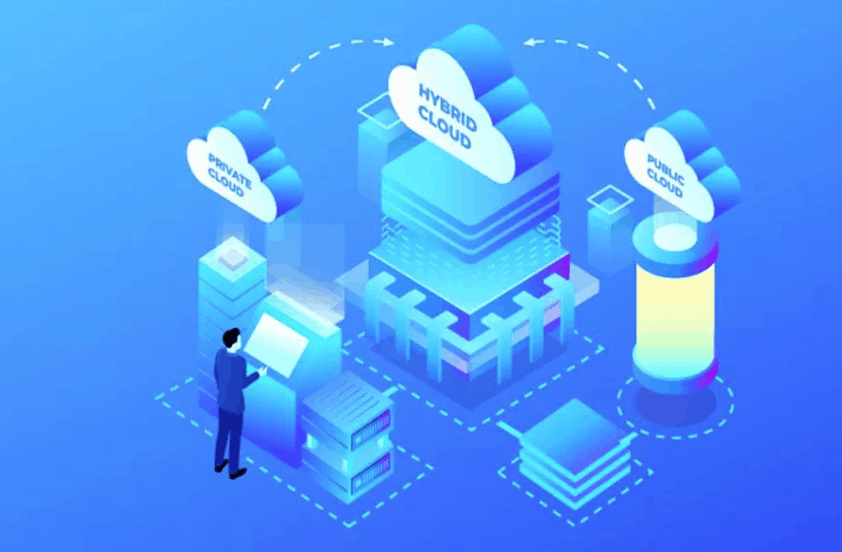Why Hybrid Cloud brings the advantages and benefits in 2020
Hybrid Cloud operates in a cloud computing environment including on-premises, Private Cloud, and Public Cloud infrastructure.
By establishing links, connections, and data exchange between these two platforms (Private Cloud and Public Cloud), Hybrid Cloud meets the needs of computing resources, security, and operating costs. flexible way, helping businesses easily operate and deploy with more choices.
The infrastructure of Hybrid Cloud
The solution includes:
- 1 Public IaaS, for example, Amazon Web Services, Google Cloud Platform or EXA IaaS
- 1 Private Cloud, which can be built in an enterprise IT infrastructure (On-Premises) or through a Private Cloud provider
- Connection (WAN) between the two environments mentioned above and meet the data exchange of two parties throughout and stable.
Typically, businesses use the public cloud for compute instances, storage, or other services.
However, for Public Cloud is provided by a third party – in most cases, Enterprises have absolutely no authority to change the infrastructure. So to deploy the Hybrid cloud, the company must build Build a Private Cloud environment (for example Virtual Private Cloud) to achieve compatibility with standard cloud / Public Cloud models.
This includes implementing the right hardware inside the data center, including servers, storage, local area networks (LANs), and possibly Load Balancers.
Next, businesses need to deploy the Virtualization layer, or Hypervisor, to create Virtual Machines or Containers. Next, the IT department sets up the Private Cloud model on the Hypervisor layer (eg Open Stack) to operate the functions of the Cloud (eg Self-Service, automation and orchestration, billing/chargeback).
A typical Private Cloud structure will have an internal service’s menu of options, for example instantiating a Compute instance, a database from which – User can instantiate.

The key factor in creating a successful Hybrid Cloud is the selection of Hypervisor and Cloud Layer to be compatible with the Public Cloud, ensuring public Cloud compatibility and operation through APIs and services. This brings smooth operation between Private and Public Cloud, making it easier for developers to deploy software that combines the use of services and resources between these two platforms.
Benefits of Hybrid Cloud
Hybrid Cloud solves the problem for businesses that have applications that need extremely large amounts of continuous access or security standards that require an enterprise to operate using the Private Cloud. For apps that allow employees to stay connected anywhere and are easily accessible through Public Cloud.
One of the most notable benefits of hybrid cloud is the cloud bursting feature. This is an application that can switch from private cloud to public cloud without interrupting work for employees or customers. This is especially useful for businesses with highly volatile, highly disruptive jobs.
For example, a retail company chooses to deploy online shopping infrastructure, a surge in customer shopping demand on holidays, or a sale off is an example of a high-efficiency image brings.
Applications can be run on the private cloud, but use the hybrid cloud to take advantage of the greater bandwidth and resources that extend from the public cloud as computational demand spikes. Flexible rotation allows users to choose the right cloud for the workload to be done. Thereby, creating redundancy plans to switch to using the public cloud when the workload exceeds the solvency of the private cloud.
Another use case of the solution is Big Data data processing. For example, a company can use cloud storage to store business, sales, audit, and other data, and then run analytics queries on the Public Cloud.
Hybrid Cloud also allows enterprises to use a broader combination of IT services. For example, an enterprise could run critical workloads in a private cloud, but simultaneously utilize the database or storage services of a Public Cloud provider.
Challenges when using Hybrid Cloud
Besides the aforementioned benefits, Hybrid Cloud computing is still challenging in terms of technical, business, and management aspects that need to be addressed. To operate the solution effectively, the Private Cloud must be connected and exchanged data smoothly with the Public Cloud provider, as mentioned above, requires API compatibility and a stable network connection.
For Public Cloud, potential connection problems, breach of service agreement (SLA) and other service interruptions may occur. To mitigate these risks, organizations can set up hybrid cloud workloads that are compatible with multiple public cloud providers. However, this can cause complexity in workload design and testing.
Another challenge with Hybrid Cloud computing is the construction, operation, and maintenance of private cloud, requiring expertise from IT staff. Deploying new software, such as databases, helpdesk systems, and other tools, can lead to complex problems.
Finally, Enterprise takes full responsibility for technical issues for Private Cloud, responding to the compatibility with Public Cloud – API and services.
Summary
Hybrid Cloud provides businesses with flexibility, scalability and compatibility, effective operating costs. To achieve efficiency, the operation, risk assessment, potential, and ability to deploy, operate are the issues that enterprises need to answer.
Finally, choosing a reputable Cloud Computing service provider is also an important condition to help businesses easily operate on this model.
By Cloud Space